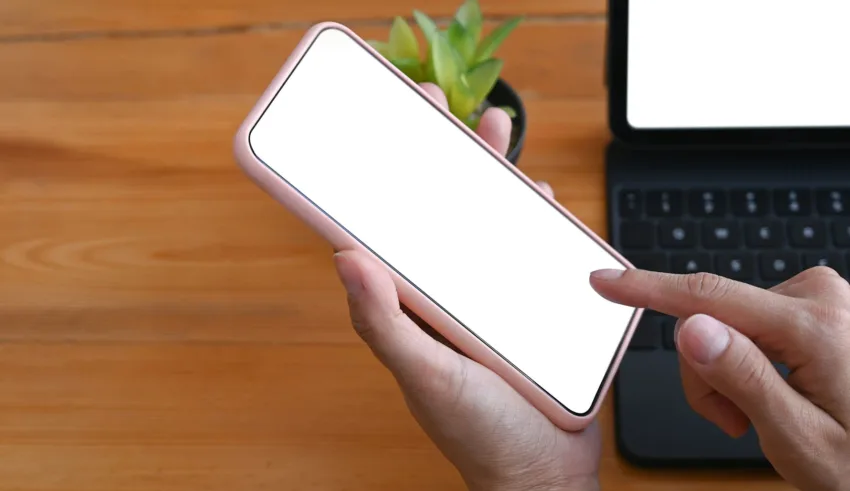
In the dazzling age of digital domination, where screens are our constant companions, it’s not just eyestrain and sleep disturbances to worry about. The captivating dance between your skin and the elusive blue light coming from your devices is a beauty saga that deserves a closer look. Get ready to decode the surprising effects of blue light on your skin in this article from The Dermo Lab in collaboration with the dermatologist Dr. Ebrahim Shaaban.
What is blue light?
Let’s start by shedding some light on the source itself. Blue light, a short-wavelength, high-energy light, is emitted by the screens of our smartphones, tablets, computers and even LED lamps. Although it is a natural component of sunlight and has benefits during the day, prolonged exposure to artificial sources, particularly in the evening, is when the situation worsens. According to Dr. Ebrahim Shaaban, most LEDs used in smartphones, TVs, and tablets have wavelengths between 400 and 490 nanometers of blue light.
Unlike natural sources of blue light, the intensity and proximity of these artificial sources expose your skin to prolonged and concentrated doses, especially considering the average number of hours spent in front of screens in the modern world.
What is skin’s digital dilemma?
Your skin, as a resilient canvas, cannot escape the influence of this modern radiation. Dr. Ebrahim Shaaban notes that prolonged exposure to high-energy blue light can increase DNA damage, tissue death, eye damage, skin barrier deterioration, and photoaging.
Let’s take a closer look at how blue light affects your skin:
- Oxidative stress and free radicals: the silent aggressors
Blue light has been associated with increased oxidative stress in the skin. Like sunlight, it generates free radicals, the famous molecules that wreak havoc on your cells. This oxidative stress can lead to the degradation of collagen and elastin, the proteins responsible for maintaining skin firmness and elasticity. The result? Fine lines, wrinkles, and a potential acceleration of the aging process.
- Hyperpigmentation: the digital fingerprint
Have you ever noticed subtle changes in your skin tone after a long day in front of the computer? Blue light has been implicated in triggering hyperpigmentation, causing dark spots and uneven skin tone. Our screens leave a digital imprint on our complexion, one pixel at a time. Dr Ebrahim Shaaban notes that one study linked exposure to blue light to pigment changes in people with darker skin.
- Disruption of circadian rhythms: the symbiotic relationship between sleep and skin
Skin and sleep are closely linked. During the night, the skin regenerates, repairs, and replenishes itself. Melatonin, the hormone that regulates the sleep-wake cycle, is crucial in this repair process. Exposure to blue light in the evening, particularly on screens, can suppress melatonin production, disrupting the sleep rhythm and, by extension, the skin’s ability to repair and rejuvenate. As a result, you risk waking up with tired, puffy, dull skin.
What are the strategies for digital skincare?
Now that we’ve revealed the potential pitfalls, it’s time to equip ourselves with strategies for navigating the digital landscape while maintaining radiant, resilient skin.
- Screen time moderation: A digital detox for your skin
While it’s unrealistic to abandon our screens altogether, moderation is essential. Incorporate screen breaks into your day, to give your eyes and skin a well-deserved respite. Consider the 20-20-20 rule: every 20 minutes, take a 20-second break and look at something 20 feet away. Your skin will thank you for the break.
- Blue light blocking: Armor for your skin
Enter the age of blue-light-blocking products. The market is catching up with our digital needs, from screen protectors to skincare infused with anti-blue-light ingredients. Look for products containing antioxidants like vitamins C and E, which can help neutralize the free radicals generated by blue light.
- Night mode: Reduce digital glare
Many devices are now equipped with a night mode, which reduces the emission of blue light in the evening. Take advantage of this function not only to promote better sleep but also to minimize the potential impact on your skin.
- Skin care superheroes: Develop a blue light defense routine
Consider incorporating skincare products that focus on defense against digital damage. Ingredients such as niacinamide and hyaluronic acid can help support the skin’s barrier function and hydration, acting as essential allies in the fight against blue-light-induced stress.
- Nutritional defense
Your diet can also play a role in protecting your skin from the effects of blue light. Incorporating antioxidant-rich foods such as berries, leafy greens, and nuts can help your skin fight oxidative stress. Antioxidants neutralize free radicals, helping to minimize the damage caused by blue light. In addition, omega-3 fatty acids, found in oily fish such as salmon, can support your skin’s natural barrier function, making it more resistant to environmental stressors.
Conclusion
In conclusion, the effects of blue light on your skin are a multi-faceted story that both intrigues and prompts caution. From oxidative stress to hyperpigmentation, our screens play a role in the evolution of our skin. By taking a mindful approach to screen time, incorporating blue light defense strategies, and adopting a holistic skincare routine, we can ensure that our skin continues to shine in the digital age. It’s not about escaping blue light, but understanding it and finding harmony in the glow of our modern world.








